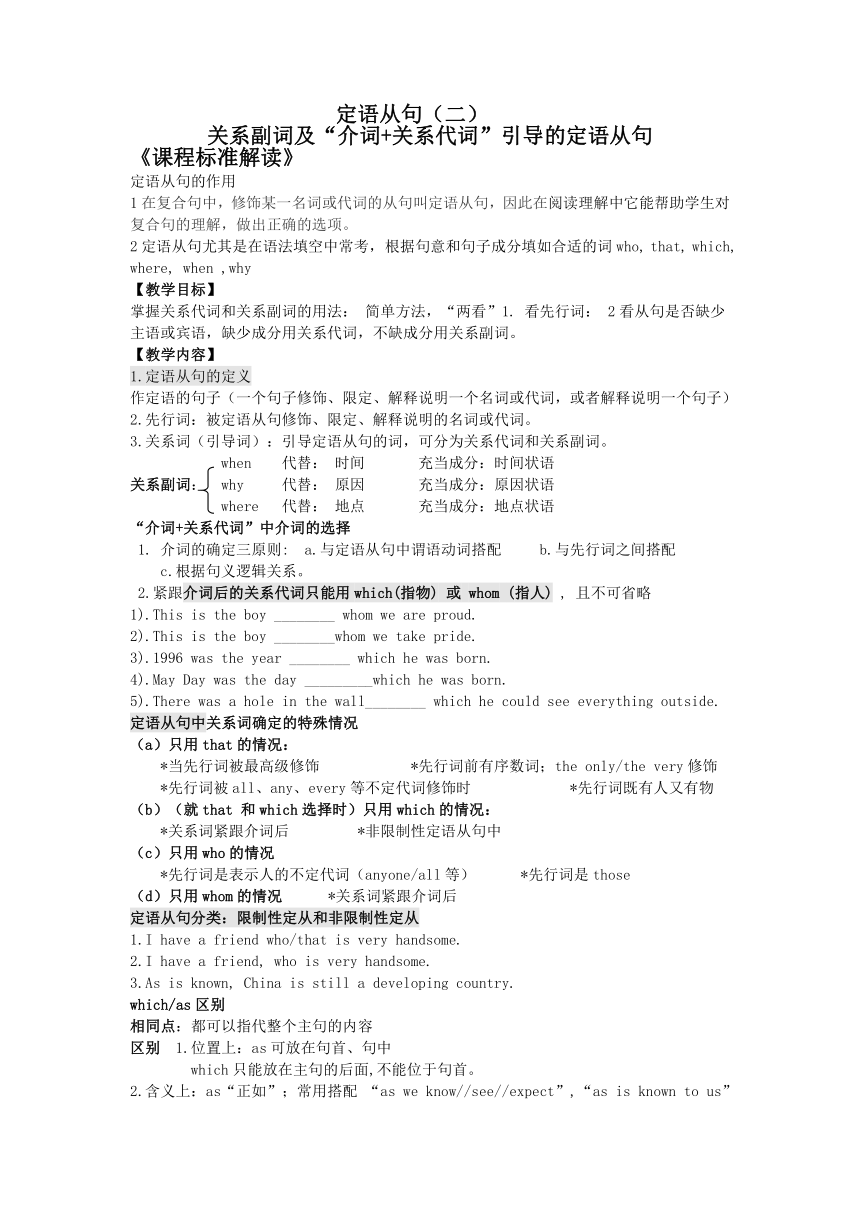人教版(2019)必修第二册Unit 1 Cultural Heritage Discovering 引导的定语从句 教学设计
文档属性
| 名称 | 人教版(2019)必修第二册Unit 1 Cultural Heritage Discovering 引导的定语从句 教学设计 |  | |
| 格式 | docx | ||
| 文件大小 | 25.4KB | ||
| 资源类型 | 教案 | ||
| 版本资源 | 人教版(2019) | ||
| 科目 | 英语 | ||
| 更新时间 | 2024-04-02 08:29:57 | ||
图片预览

文档简介
定语从句(二)
关系副词及“介词+关系代词”引导的定语从句
《课程标准解读》
定语从句的作用
1在复合句中,修饰某一名词或代词的从句叫定语从句,因此在阅读理解中它能帮助学生对复合句的理解,做出正确的选项。
2定语从句尤其是在语法填空中常考, 根据句意和句子成分填如合适的词who, that, which, where, when ,why
【教学目标】
掌握关系代词和关系副词的用法: 简单方法,“两看”1. 看先行词: 2看从句是否缺少主语或宾语,缺少成分用关系代词,不缺成分用关系副词。
【教学内容】
1.定语从句的定义
作定语的句子(一个句子修饰、限定、解释说明一个名词或代词,或者解释说明一个句子)
2.先行词:被定语从句修饰、限定、解释说明的名词或代词。
3.关系词(引导词):引导定语从句的词,可分为关系代词和关系副词。
when 代替: 时间 充当成分:时间状语
关系副词: why 代替: 原因 充当成分:原因状语
where 代替: 地点 充当成分:地点状语
“介词+关系代词”中介词的选择
介词的确定三原则: a.与定语从句中谓语动词搭配 b.与先行词之间搭配
c.根据句义逻辑关系。
2.紧跟介词后的关系代词只能用which(指物) 或 whom (指人) , 且不可省略
1).This is the boy ________ whom we are proud.
2).This is the boy ________whom we take pride.
3).1996 was the year ________ which he was born.
4).May Day was the day _________which he was born.
5).There was a hole in the wall________ which he could see everything outside.
定语从句中关系词确定的特殊情况
(a)只用that的情况:
*当先行词被最高级修饰 *先行词前有序数词;the only/the very修饰
*先行词被all、any、every等不定代词修饰时 *先行词既有人又有物
(b)(就that 和which选择时)只用which的情况:
*关系词紧跟介词后 *非限制性定语从句中
(c)只用who的情况
*先行词是表示人的不定代词(anyone/all等) *先行词是those
(d)只用whom的情况 *关系词紧跟介词后
定语从句分类:限制性定从和非限制性定从
1.I have a friend who/that is very handsome.
2.I have a friend, who is very handsome.
3.As is known, China is still a developing country.
which/as区别
相同点:都可以指代整个主句的内容
区别 1.位置上:as可放在句首、句中
which只能放在主句的后面,不能位于句首。
2.含义上:as“正如”;常用搭配 “as we know//see//expect”,“as is known to us”
“as is often the case(这是常事)”
which“这;这件事”
例如:1).____________we know, the earth moves around the sun.
2).She passed the exam,_____________ made his parents very happy.
定语从句的主谓一致问题
定语从句谓语动词单复数取决于先行词,但要注意下列情况:例如:
1).Tom is one of the students who _____________(was, were) awarded.
2).Tom is the only one of the students who _____________(was, were) awarded.
One of the students __________ (was, were) awarded yesterday.
定语从句中关系代词充当成分,无需再使用代词(改错)
(改错)He is the man I want to turn to him for help.
非限制性定语从句和并列句的区别
1).He has two sons, both of ___________ are teachers.
2).He has two sons, and both of____________ are teachers.
定语从句与强调句的区别
1).It was at midnight_________ we arrived home.
2).It was midnight _________we arrived home.
定语从句特殊先行词
way在从句中做状语用that// in which//不填; 做主、宾正常用that//which
case/point/condition/situation/activity/scene在从句中作状语用where;
做主、宾正常that// which
1).What surprised me was not what he said but the way_________ he said it.
2).The way ____________he explained to us was quite simple.
3).After graduation she reached a point in her career __________she needed to decide
what to do.
4).—Do you have anything to say for yourselves
—Yes, there’s one point _______________ we must insist on.
5).Can you think out a situation ____________ this idiom (习语) can be used
6).The international situation ________ we have to face is becoming worse and worse.
定语从句考点特殊结构
as 引导限制性定语从句 as既可指人也可指物,在从句中作主语、宾语或表语
so//such… as…(引导定语从句;从句中成分不完整)
so //such… that … (引导状语从句;从句中成分完整)
7).He is so clever a boy// such a clever boy _________ we like him.
8).He is so clever a boy //such a clever boy __________we like.
【实战演练】
1.Tom is a boy, _________ every classmate loves.
2.There is a bus on the road , _________tyres(轮胎) are broken .
3.I made a new friend yesterday , ________ name was Tom.
4.He passed the exam just now ,________ made his parents very proud.
5.This is the school __________ I love very much.
6.This is the school __________ I used to live.
【提问学生】
【教学反思】
关系副词及“介词+关系代词”引导的定语从句
《课程标准解读》
定语从句的作用
1在复合句中,修饰某一名词或代词的从句叫定语从句,因此在阅读理解中它能帮助学生对复合句的理解,做出正确的选项。
2定语从句尤其是在语法填空中常考, 根据句意和句子成分填如合适的词who, that, which, where, when ,why
【教学目标】
掌握关系代词和关系副词的用法: 简单方法,“两看”1. 看先行词: 2看从句是否缺少主语或宾语,缺少成分用关系代词,不缺成分用关系副词。
【教学内容】
1.定语从句的定义
作定语的句子(一个句子修饰、限定、解释说明一个名词或代词,或者解释说明一个句子)
2.先行词:被定语从句修饰、限定、解释说明的名词或代词。
3.关系词(引导词):引导定语从句的词,可分为关系代词和关系副词。
when 代替: 时间 充当成分:时间状语
关系副词: why 代替: 原因 充当成分:原因状语
where 代替: 地点 充当成分:地点状语
“介词+关系代词”中介词的选择
介词的确定三原则: a.与定语从句中谓语动词搭配 b.与先行词之间搭配
c.根据句义逻辑关系。
2.紧跟介词后的关系代词只能用which(指物) 或 whom (指人) , 且不可省略
1).This is the boy ________ whom we are proud.
2).This is the boy ________whom we take pride.
3).1996 was the year ________ which he was born.
4).May Day was the day _________which he was born.
5).There was a hole in the wall________ which he could see everything outside.
定语从句中关系词确定的特殊情况
(a)只用that的情况:
*当先行词被最高级修饰 *先行词前有序数词;the only/the very修饰
*先行词被all、any、every等不定代词修饰时 *先行词既有人又有物
(b)(就that 和which选择时)只用which的情况:
*关系词紧跟介词后 *非限制性定语从句中
(c)只用who的情况
*先行词是表示人的不定代词(anyone/all等) *先行词是those
(d)只用whom的情况 *关系词紧跟介词后
定语从句分类:限制性定从和非限制性定从
1.I have a friend who/that is very handsome.
2.I have a friend, who is very handsome.
3.As is known, China is still a developing country.
which/as区别
相同点:都可以指代整个主句的内容
区别 1.位置上:as可放在句首、句中
which只能放在主句的后面,不能位于句首。
2.含义上:as“正如”;常用搭配 “as we know//see//expect”,“as is known to us”
“as is often the case(这是常事)”
which“这;这件事”
例如:1).____________we know, the earth moves around the sun.
2).She passed the exam,_____________ made his parents very happy.
定语从句的主谓一致问题
定语从句谓语动词单复数取决于先行词,但要注意下列情况:例如:
1).Tom is one of the students who _____________(was, were) awarded.
2).Tom is the only one of the students who _____________(was, were) awarded.
One of the students __________ (was, were) awarded yesterday.
定语从句中关系代词充当成分,无需再使用代词(改错)
(改错)He is the man I want to turn to him for help.
非限制性定语从句和并列句的区别
1).He has two sons, both of ___________ are teachers.
2).He has two sons, and both of____________ are teachers.
定语从句与强调句的区别
1).It was at midnight_________ we arrived home.
2).It was midnight _________we arrived home.
定语从句特殊先行词
way在从句中做状语用that// in which//不填; 做主、宾正常用that//which
case/point/condition/situation/activity/scene在从句中作状语用where;
做主、宾正常that// which
1).What surprised me was not what he said but the way_________ he said it.
2).The way ____________he explained to us was quite simple.
3).After graduation she reached a point in her career __________she needed to decide
what to do.
4).—Do you have anything to say for yourselves
—Yes, there’s one point _______________ we must insist on.
5).Can you think out a situation ____________ this idiom (习语) can be used
6).The international situation ________ we have to face is becoming worse and worse.
定语从句考点特殊结构
as 引导限制性定语从句 as既可指人也可指物,在从句中作主语、宾语或表语
so//such… as…(引导定语从句;从句中成分不完整)
so //such… that … (引导状语从句;从句中成分完整)
7).He is so clever a boy// such a clever boy _________ we like him.
8).He is so clever a boy //such a clever boy __________we like.
【实战演练】
1.Tom is a boy, _________ every classmate loves.
2.There is a bus on the road , _________tyres(轮胎) are broken .
3.I made a new friend yesterday , ________ name was Tom.
4.He passed the exam just now ,________ made his parents very proud.
5.This is the school __________ I love very much.
6.This is the school __________ I used to live.
【提问学生】
【教学反思】
